She feels really easy and comfortable to sail, even in a good breeze and a chop.
- Spirited performance – fast and fun
- Useful range and easy charging
- Range-extender battery doubles the running time
- Lightweight package
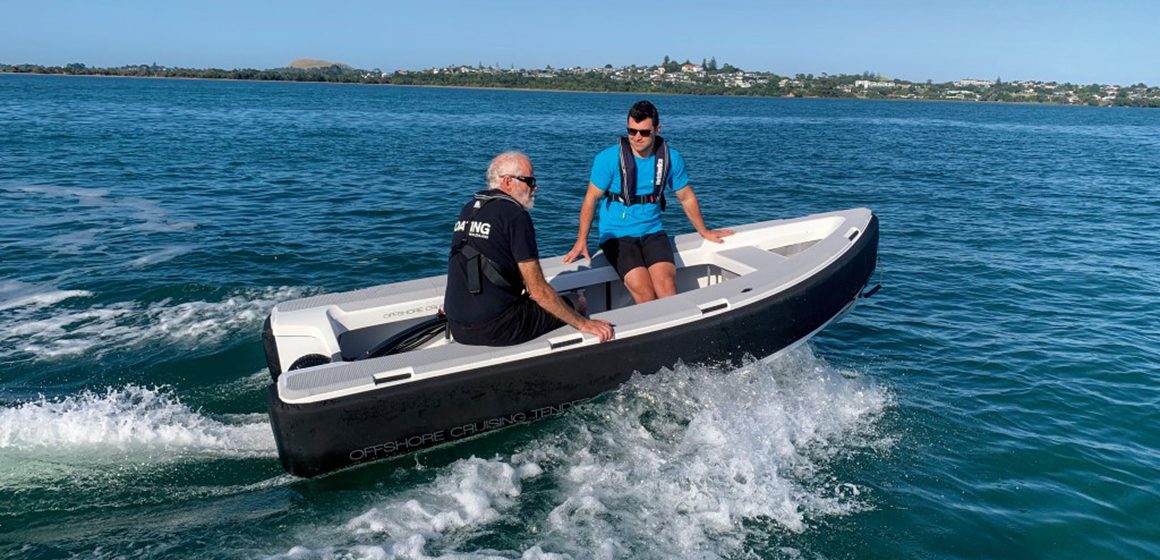
According to a quote in the United Nation’s Our World publication, “the future has arrived, and it is electric”.
A cynic will quite rightly take anything coming from the UN with a grain of salt, but the benefits of electric power are impossible to ignore. And so, when ZeroJet told us they had developed an innovative electric-powered jet boat, we had to take a look – well, actually, have a play!
The basis for the review boat is an elegantly designed 3.5m cruising yacht tender made by Offshore Cruising Tenders (OC Tenders). Featured previously in this magazine, these are stylish, superbly lightweight, dry and stable boats with a wide fender strip running right around the boat. They are made to be easily manageable, include a flat, wide deck that is stable to get into from a dock and they can also easily run up on the beach. With the option of a carbon fibre hull, these tenders are super-light and easy to move around.

However, what makes this particular boat unique is a ZeroJet electric marine jet propulsion system – and to the uninitiated it is a bit confusing: where is the motor? Welcome to what is claimed to be the world’s lightest electric jet system, where an impossibly tiny cowling covers the equivalent of a 20hp electric waterjet system.
Eight years in the making, the ZeroJet story starts with them setting up in Perth to import, sell and hire out the Czech-made Jetsurf boards, powered by a conventional two-stroke petrol engine. This was an incredibly successful venture, but the dynamic founding duo of Bex Rempel and Neil Mans returned home to New Zealand to start their journey developing environmentally friendly electric-powered jet boats.
After a few years spent on research and development into an electric jet board, during which they achieved some significant milestones, they realised the real demand for electric solutions was in the boating industry. Reluctantly leaving the fun of the jetboards behind them, they rebranded as ZeroJet and developed a lightweight and efficient Jetpod system, designed for a tender or similar modest-sized hull. A collaboration with OC Tenders allowed them to concentrate on the propulsion systems without needing to also build boats.

The ZeroJet is currently available on four models of the OC range, from the 300 up to the newly released 400. The hulls are available in fibreglass or carbon, with carbon being lighter but slightly more expensive. We got to play with the OC350, and it was a blast!
Although not the first electric jet on the market, other brands are all considerably larger. When we opened that tiny cover inside the hull of the OC350, at first all we could see was the overall shape of a largely conventional, but tiny, water jet. Hidden just under the forward lip was a tiny coffee-pot sized black cylinder, which is the electric motor itself. That tiny unit produces the equivalent of almost 20hp, which is amazing when you think how big and heavy a conventional 20hp internal combustion engine usually is.
Steering the ZeroJet is through a carbon-fibre tiller, with the throttle and other controls on the end, much like a tiller-steered petrol outboard. The jet bucket to engage reverse is operated by a lever on the port side of the engine cover. Looking over the stern we saw a conventional looking waterjet nozzle, slightly smaller in size than those found on jet-skis. Notably there is a large black ride plate, or trim tab, located just below the jet output. Declan Price, Sales Manager for ZeroJet, explained that it served a dual purpose: it made the waterjet output more controlled, and it also hid a heat exchanger that worked like a conventional inboard keel cooler.
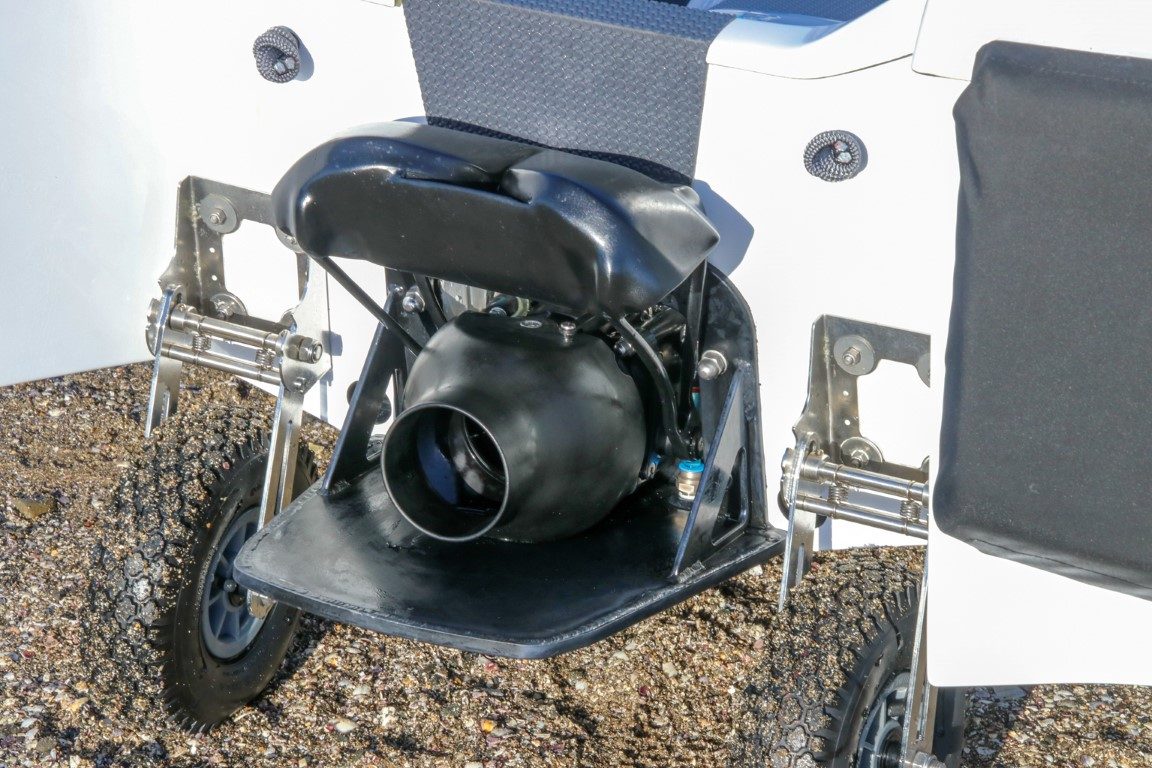
This was an important development for the ZeroJet system. Saltwater and electrics do not mix well, but electric motors generate heat and require cooling. Hence the internal systems are cooled by a special cooling liquid, which is visible through a sight glass on top of the motor. The cooling liquid is passed through the hydrofoil heat-exchanger plate which is sealed to saltwater ingress. This keeps everything under control with little or no maintenance required, and particularly no saltwater pump or impeller to worry about.
When developing any electrical solution, the designers must balance voltage and current. Higher voltages equal lower amperage, thinner cables and less heat generated in those cables. This is why many electric cars operate battery voltages as high as 350 volts. Naturally this voltage can be extremely dangerous, especially in a boat used in a marine environment, so instead ZeroJet have opted for a modest 48V operating voltage.
That power is provided by a pair of lithium iron phosphate batteries, tucked one under each gunwale. A fully sealed display on the side shows the status of the batteries, and a similarly waterproof connector accepts the charging cable from home or the mother ship. Slow and fast chargers are both provided. The standard configuration provides 5kWh of battery capacity, which according to Price is good for more than an hour and a half of normal operation. A 10kWh range extender battery is also available as an option.
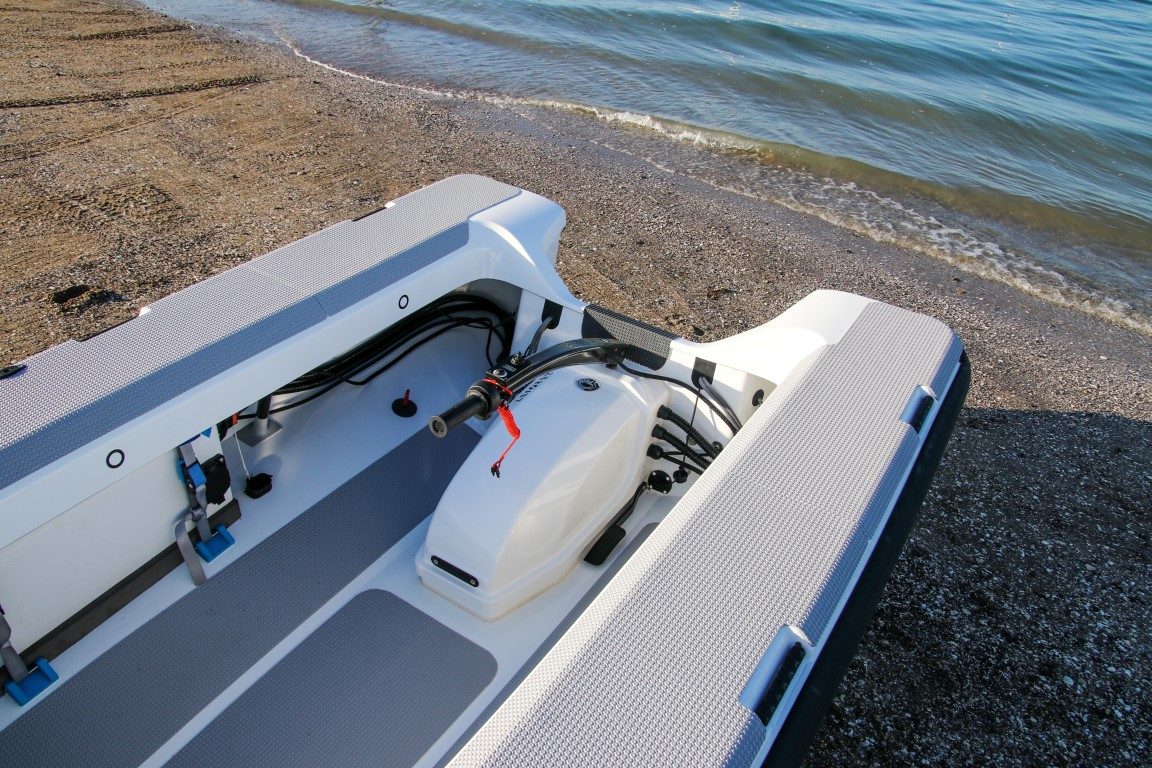
Most of the weight is of course in those batteries, with the entire ZeroJet system coming in at 129kg with the standard battery, or 174kg with the extended option. Thanks to that carbon fibre hull the whole boat was light enough for three people to comfortably lift on and off the trailer. Of course, we could have done this the conventional way using the winch and the boat ramp, but other ramp traffic on the day meant it was quicker for us to simply lift it over a railing and onto the beach. No problem!
Enough specs, it was time to play! We got into the boat, attached the safety lanyard, and turned on the controls. The system goes through a self-check, and in about 10 seconds is ready for use. Like most electric systems, it is slightly freaky that there is absolute silence even though the engine is raring to go. I started out with a tentative twist of the tiller throttle, the motor hummed, and we eased forward.
The steering is incredibly light, since you are not trying to turn the heavy metal bulk of a conventional outboard. That carbon fibre tiller, itself almost a work of art, was perfect for the job. Once we were clear of moored boats I could give it a full tonk, and luckily Price told me she is capable of a massive turn of speed, so I knew to hold on. She shot off, scooting at well over 20 knots, which is impressive for such a small motor. The manoeuvrability was also impressive, with very tight turns at any speed easy and comfortable to do.
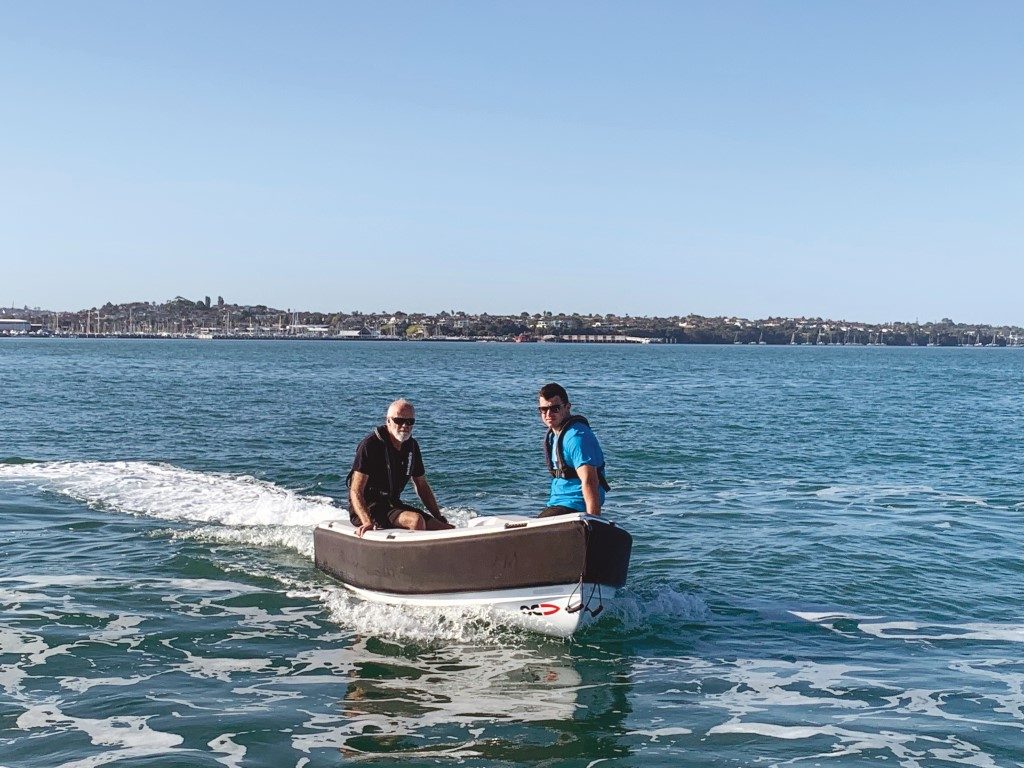
Like all waterjet craft, the boat has no steering unless water is coming out of the jet nozzle, which sadly results in jetski crashes each year. To mitigate this, ZeroJet have adapted the usual reverse bucket on the jet unit to also act like an emergency brake.
Unlike many waterjets, the bucket can safely be dropped into place at any speed. Simply lift the reverse bucket lever and the boat comes to a complete halt within its own length. This has been tested at full throttle, with no damage to the boat or running gear, although you would need to be holding on very tightly indeed before attempting such a manoeuvre. We did not need to utilise this feature but did try out motoring in reverse. This was suitably impressive with full steering control in reverse, even with such a simple tiller steering mechanism.
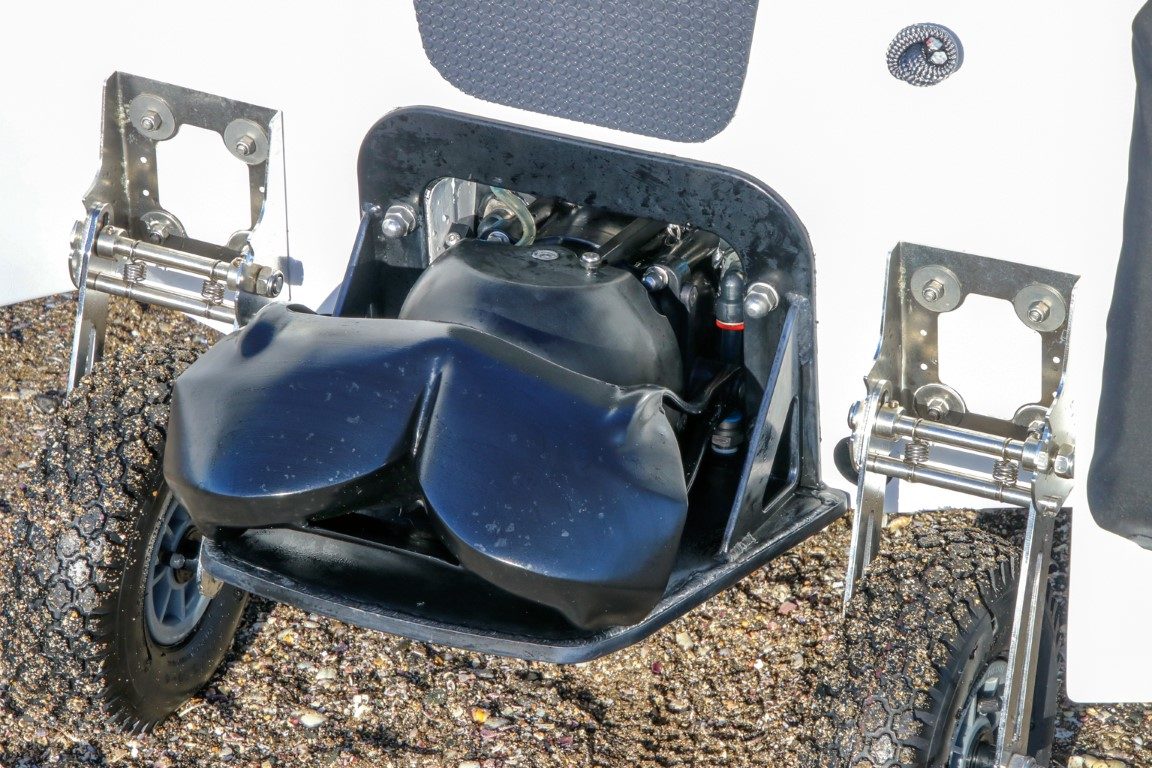
This is a stunning little boat – fast and fun with all the green credentials the industry is starting to demand. Although pitched towards the market for yacht tenders, the OC Tenders ZeroJet combo would make a great little eco-friendly runabout as well. There is enough charge to travel 10 or 15 nautical miles on the standard battery, with the range extender option doubling that distance. The display always shows the battery status, so you can manage remaining charge accordingly, with slower speeds increasing the range and higher speeds reducing it correspondingly.
ZeroJet has experienced a lot of demand over the last few months with build slots now 6-8 months away and growing fast. ZeroJet is encouraging potential customers to secure a build slot with refundable deposit if they want a boat this year.
Of course, R&D never stops, and ZeroJet have a larger system in development – more details later in the year.
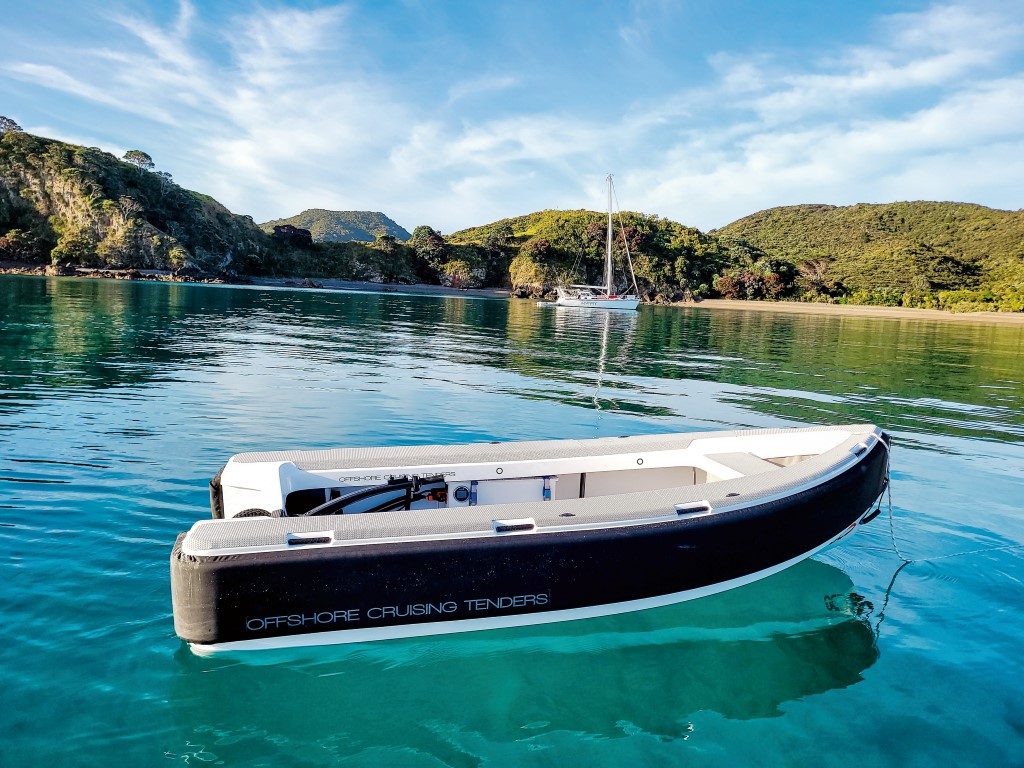
She feels really easy and comfortable to sail, even in a good breeze and a chop.
At first glance the boat appears to be a large centre console, although hidden beneath the console and forward area is a sizeable overnight cabin.
With classic styling, good performance and class-leading ride and handling, there’s a lot to like about the Caribbean 32.
Solar panels on the vast roof help keep the batteries charged.